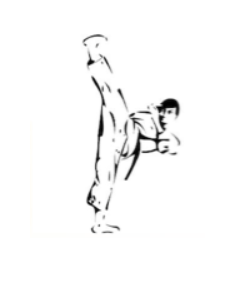TAEKWON-DO……A Way of life Although recently introduced to the western world, Taekwon-Do has for centuries been an integral part of Korean society. Not only is it an important part of Korean culture and heritage, it is also, in every sense of the word, a martial art, practiced throughout Korea on the military training fields and in the gymnasiums of all of the high schools and universities.
Translated literally, Taekwon-Do means “art of hand and foot fighting.” It is more than just that, however. It is the scientific use of the body in methods of self-defense, a body that has gained the ultimate use of its facilities through intensive physical and mental training. It is a martial art that has no equal in either power or technique. Though it is a martial art, its discipline, techniques, and mental training are the mortar for building a strong sense of justice, fortitude, humility, and resolve. It is this mental conditioning that separates the true practitioner from the sensationalist content with mastering only the fighting aspects of the art.
Throughout the world, there are numerous styles of “hand and foot fighting.” In China it is given the names Koon-Tao, Kung Fu, or Daeji-Chen; in Japan, Karate or Kempo, in Malaysia, Basilat; in Thailand, kick boxing; in France, Savate; and in India, Selambam. Some of these forms of self-defense are as old as mankind itself, and it would be impossible to trace hand and foot fighting of today back to any single beginning. There are certainly many legends regarding the origin of hand and foot fighting, and too often have some let legend be accepted as truth.

There are some authorities, who believe that a renowned Buddhist monk, Daruma Daesa, journeyed from India to China via the Himalayas to instruct the Liang dynasty monarch on the tenets of Buddhism. Upon his arrival in China, it is claimed that he went to a monastery called Shaloin Szu to begin his teachings of Buddhism to the Chinese monks. They reportedly became physically exhausted from the severe discipline and intense pace that was set by Daruma. To train themselves to accept the harshness of the discipline, Daruma began to introduce a method of physical and mental discipline outlined in the Se Kun-Kyong to free themselves from all conscious control, in order to attain enlightenment. Eventually, through this training, they supposedly became the most formidable fighters in China.
There is little historical data to substantiate this theory. Upon careful scrutiny of historical data, It appears that Daruma came into China during the Yang Dynasty of the sixth century and arrived by sea, not by land. Daruma initially attempted to teach Buddhism to King Moo Je at Kwang Joo, but was refused admission to the palace grounds. The missionary then went to a small country in the north of China called Ui, where he was invited to teach King Myong Je. Daruma, for some unknown reason, refused the offer and remained at Ko san So Rim temple in meditation and devotion until his death nine years later.

Some theories are more highly glossed than others and arguments about the origins of open hand and foot fighting will continue. There are theories that the art originated in Okinawa, in Japan, and in Korea. The Chinese theory, however, is most readily accepted since China was the cradle of Oriental culture; but this does not necessarily mean the martial arts as well had their beginning there. Again, the Koreans also have their theories with documents and wall drawings substantiating their claim. Perhaps the best answer is that open hand and foot fighting did not originate in any one country, but instead it was a natural development which occurred in different places as it was needed for defense, the method of development differing according to time and place.
Although uncertain as to the country, the race, or the time, we consider it an undeniable fact that ever since time immemorial, there have been physical actions involving the use of the hands and feet for the purpose of self-protection. So, if we define these primitive actions as Taekwon-Do, any country may claim credit for the origins of Taekwon-Do.
However, the Taekwon-Do which is today being taught to almost fifteen million eager students in more than sixty countries, differs greatly from other martial arts. Since the theory, phraseology, terminology, techniques, systems and methods, as well as spiritual foundations of Taekwon-Do, were scientifically developed, systematized, and named by the author, it is an error to think of any physical actions using hands and feet for self-defense as being Taekwon-Do, as well as a mistake for any other martial arts system to call itself Taekwon-Do. It is, therefore, obvious that the home of Taekwon-Do will clearly depend upon the nationality of its founder.
TKD History
- 6th centuary A.D Korea divided
- Soo Bak Martial art created
- Hwa rang do principals create Soo Bak-Gi
- Soo Bak introduced to China as Kwon Bup and Japan as a form of Jujitsu
- 1401-1408 Yi Dynasty recruited Taek Kyon experts
- 1909-1945 Japanese forbid any martial arts practice in Korea
- Taek Kyon secretly practiced
- 1945 Korea liberated from Japan
- 1946 a young army lieutenant Choi Hong Hi began teaching his martial arts to soldiers
- The rest is history…
